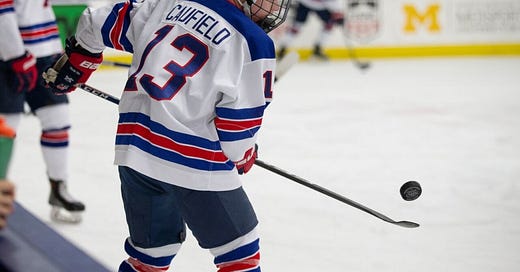Cole Caufield broke many of the goal-scoring records at the USA National Team Development Program (USNTDP). He’s the program’s all-time leading goal scorer.
He can score, but he’s only 5’8”, much smaller than almost all of his competition. Given this disadvantage, he must find different ways to score. Going to the net and battling it out with a defenseman won’t get it done at Caufield’s size.
So how does Caufield score? A combination of timing, understanding the defenders better than they know themselves, weight shifts, and technically solid shooting technique.
Caufield sat down on a podcast with Marc Dumont to talk about his game. One of our favorite writers, David St Louis, also wrote up a great piece for Habs Eyes on the Prize based on Caufield’s podcast.
Timing
“Timing is pretty much the biggest part of it. You don’t want to rush to a spot. Do that, and the play is going to get taken away pretty fast.”
On our Hockey IQ Podcast, EP Rinkside’s Mitch Brown talked about the three common types of goals you’ll see in junior hockey that don’t exist (at least, with any regularity) in the NHL
Long-range shots. Picking on goalies with less skill and taking advantage of the large amount of time afforded by junior-level defensemen.
Outside lane net drive. Picking on players who struggle to skate/pivot or have poor threat awareness.
Standing near the crease and whacking home rebounds and tips. Timing is not required and the player is often unguarded or (at a minimum) not tied up.
“Going up the levels, you see the timing is the most important part: kind of getting into the right area at the right time.”
There are key elements to timing - right place, right speed, & right time. You’ll see Caufield (#13 in the clip below) is almost always maintaining his momentum and sneaking in and out of space.
“If you’re going to rush into something, it’s just not going to work. There are times for it and there are also times to slow it down.”
When playing the game, everyone wants speed. Speed of foot, speed of hand, speed of mind. Yet, when it comes to controlling the speed of the game, fast is not always better.
In general,
Play fast/speed up when the opposition is out of position. Catch them in bad and awkward spots.
Slow down the play when the opposition is in their defensive structure. Use routes and controlled reads.
Weight Shifts & Technique
“It’s all in his feet.” - Caufield talking about Auston Matthews’ shot
Just as skating really starts with the upper body, shooting really starts with the feet. Players with great shots can shoot off either foot and know which foot they are about to use.
“A lot of the stuff I worked on last year in the summer was being able to shoot off both legs and making the defender do what you want so you can know what foot you’re going to shoot off of.”
Both Caufield and Matthews love to utilize the drag shot, where they pull the puck into their feet to change the angle before shooting. This is something Matthews has mastered, where he is moving from left foot to right foot. Getting granular… you’ll see him getting slightly onto the outside edge - that is full commitment to transferring weight.
Understanding the D
“You’re not going to be at to shoot from right in front of the net. That’s where the defense is told to be.”
Where are the holes in the defense? Where are the passing lanes? What are the rotations? Understanding all of this is more important than simply getting to the front of the net. Forcing the opposition to cover large spaces leads to offensive success.
“You’re trying read more the defenseman’s stick rather than trying to pick a corner.”
The primary goal of any shot is to make sure it gets through to the net. Caufield is seeking to read the defender. He already knows where the net is and the approximate area he is shooting. The shot doesn’t have to hit the post before going in. In fact, it rarely does.
“Time it out so when you make your move you know what the defenseman is going to do based on his hand position.”
Here, Caufield is talking about reading the top hand of the defender. He wants to know if the defender is looking to block, poke check, or retreat. If the defender’s hands are tight on their body and centralized, they are likely blocking and going to be stationary. If the top hand is more to the side, they’re likely going stick-on-puck and trying to deflect the puck away. In which case, his variety of shots (such as the drag shot) will be highly effective.
Further Reading - Learn why Cole Caufield has the skills that transfer and the skills that will last
Did you enjoy this newsletter?
Help us spread the ideas within and share it with the people you care about





